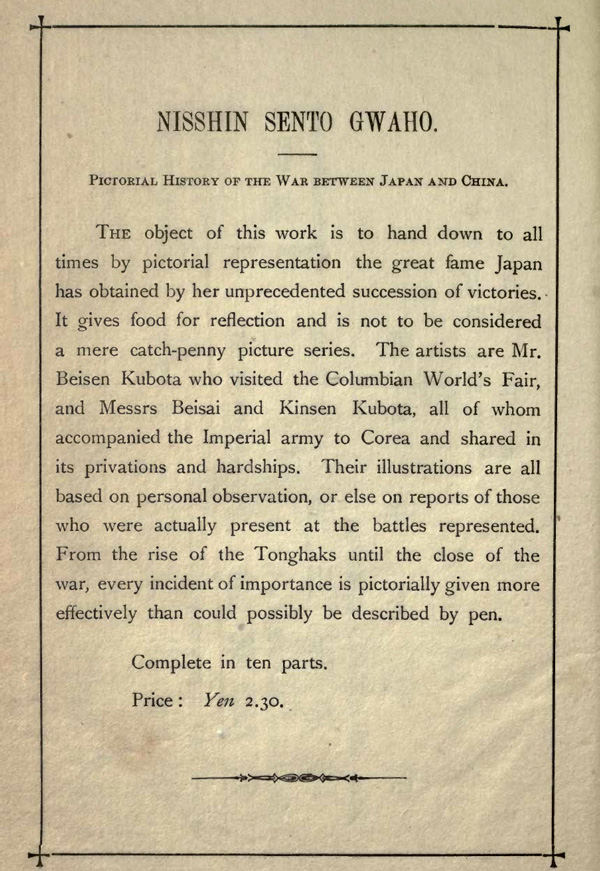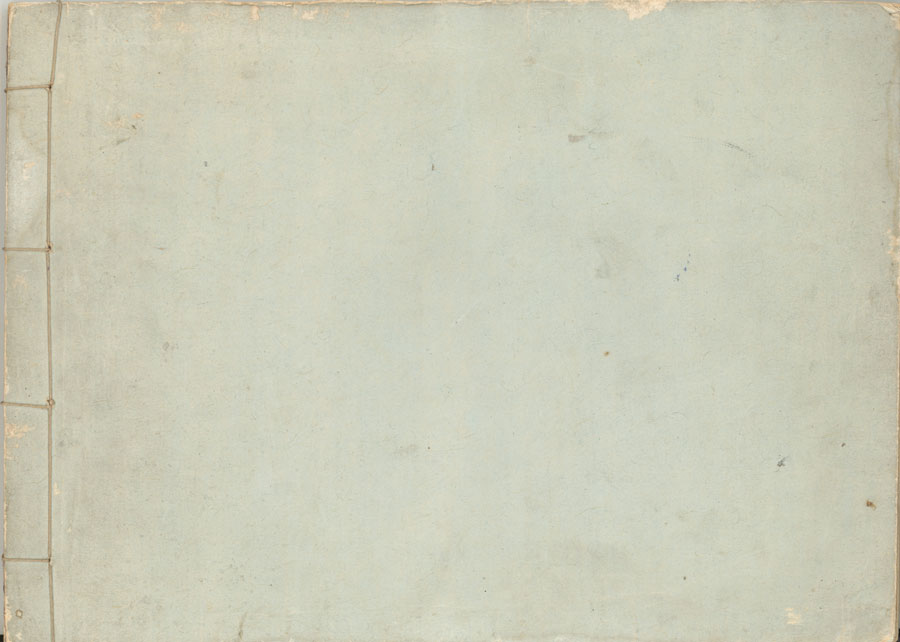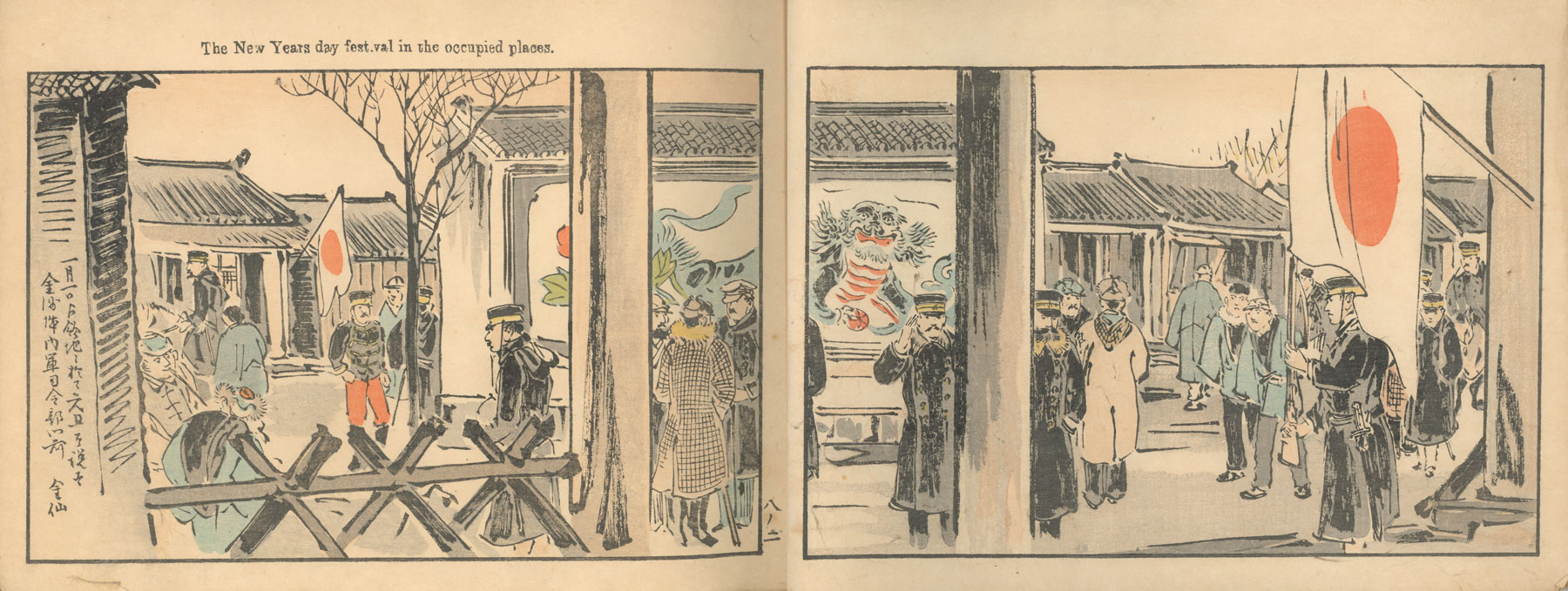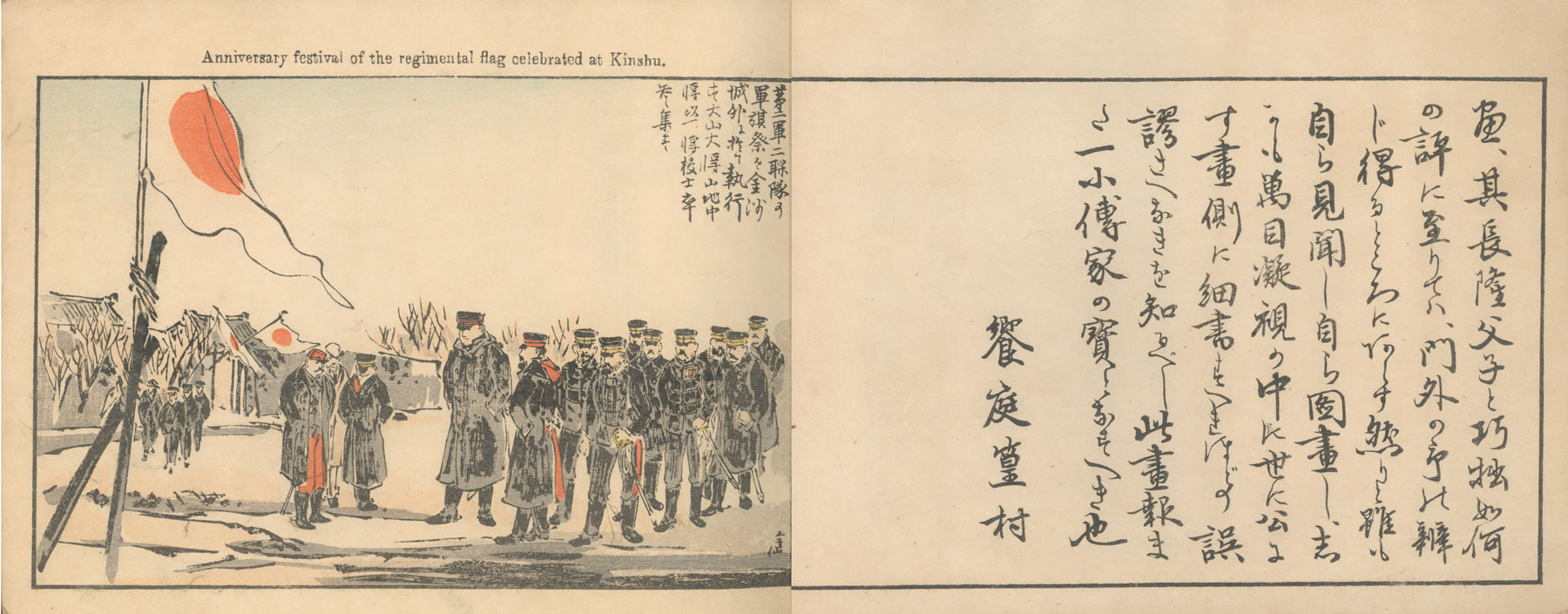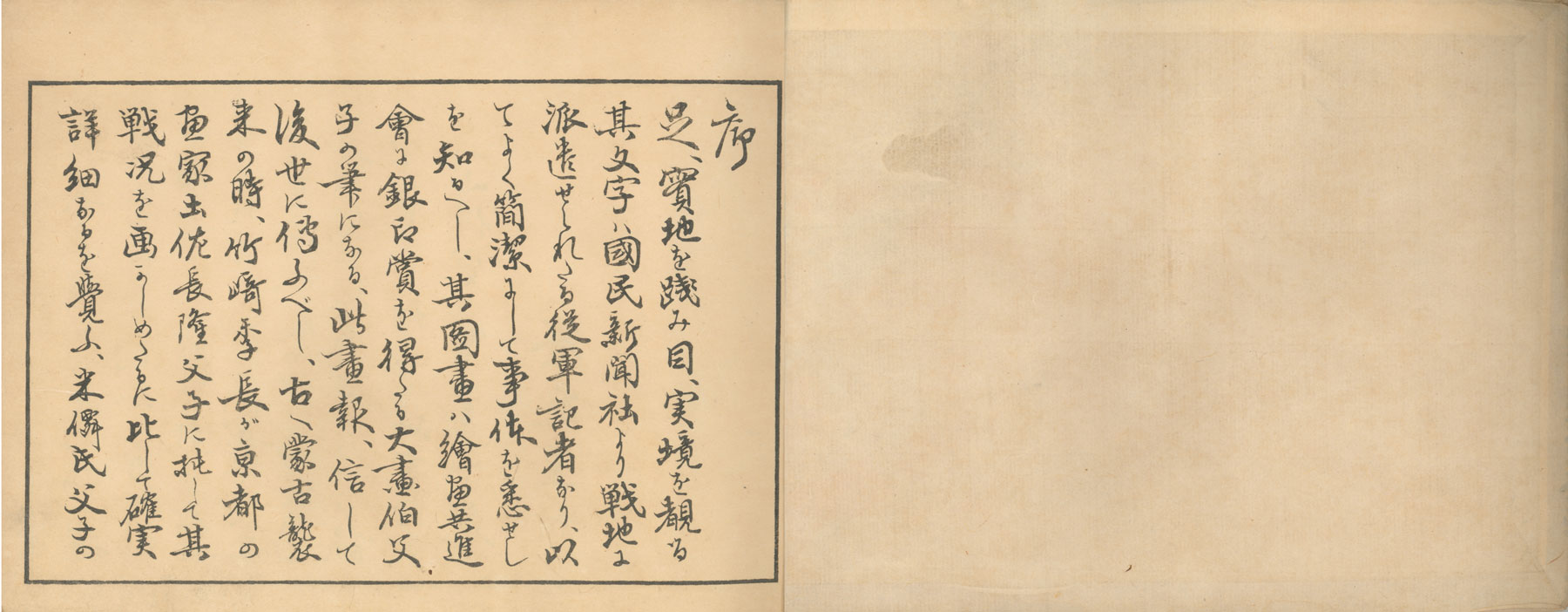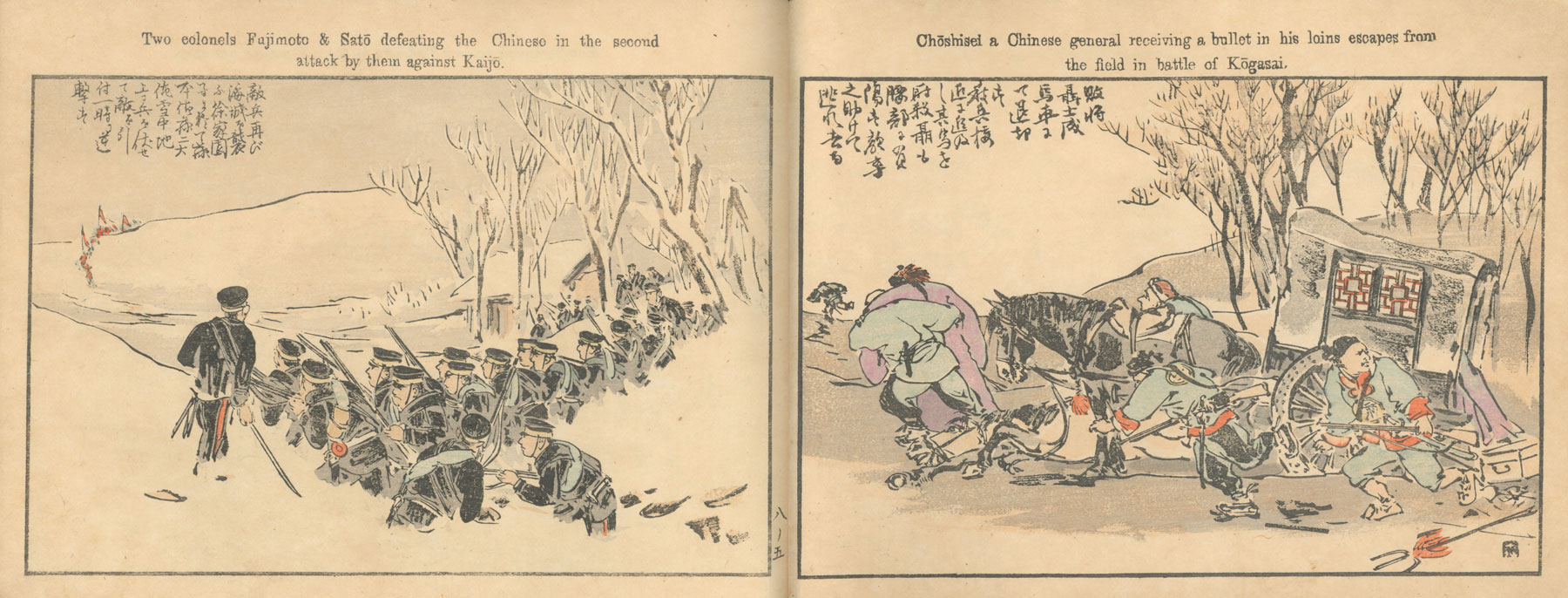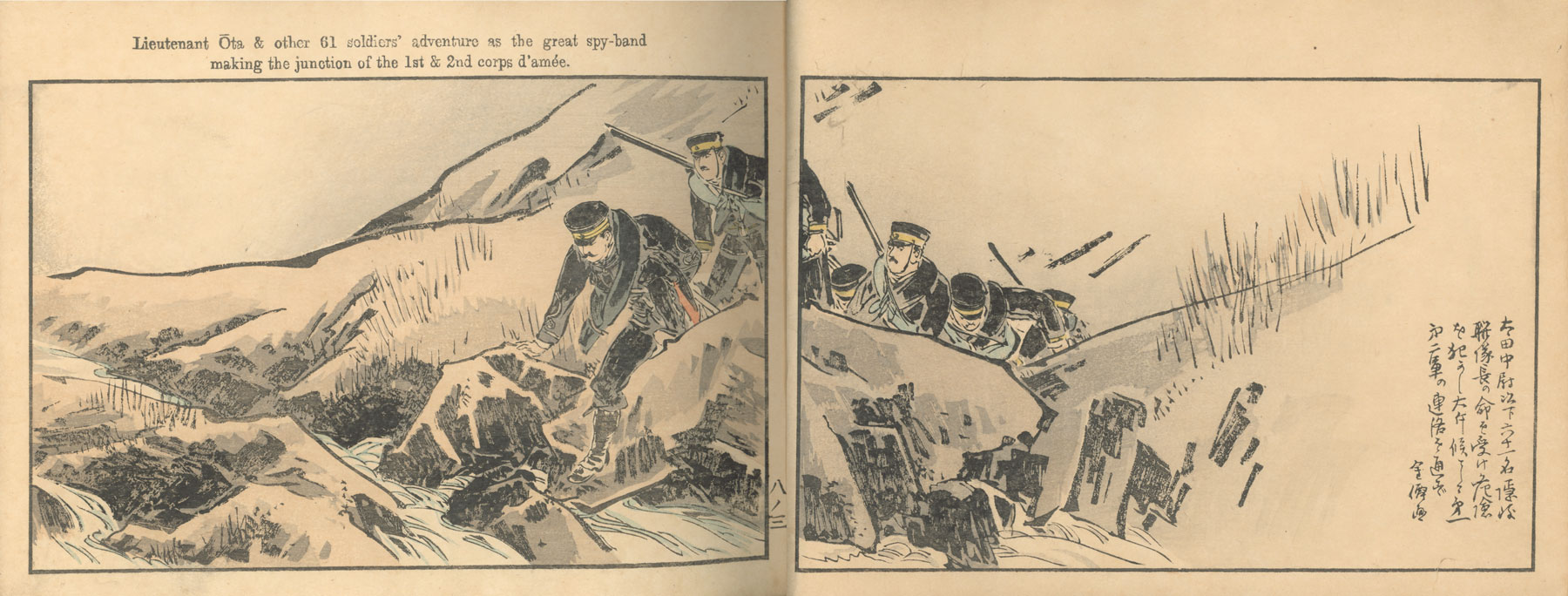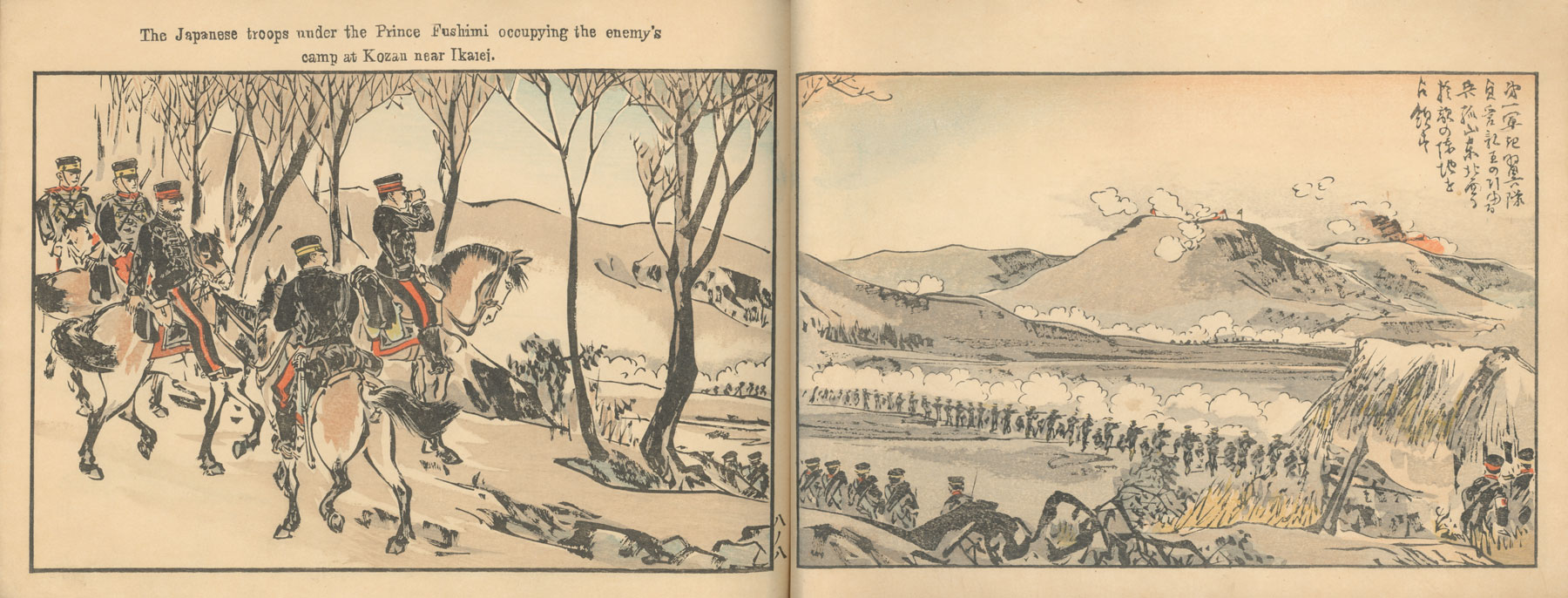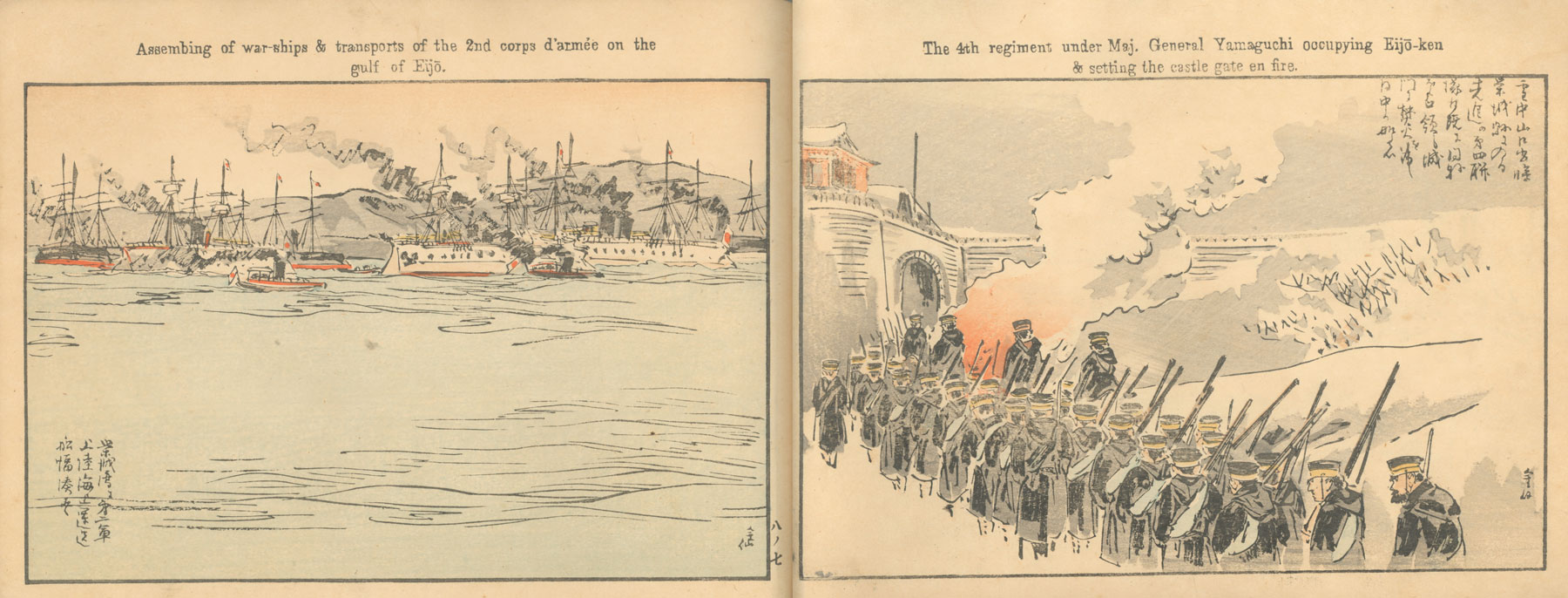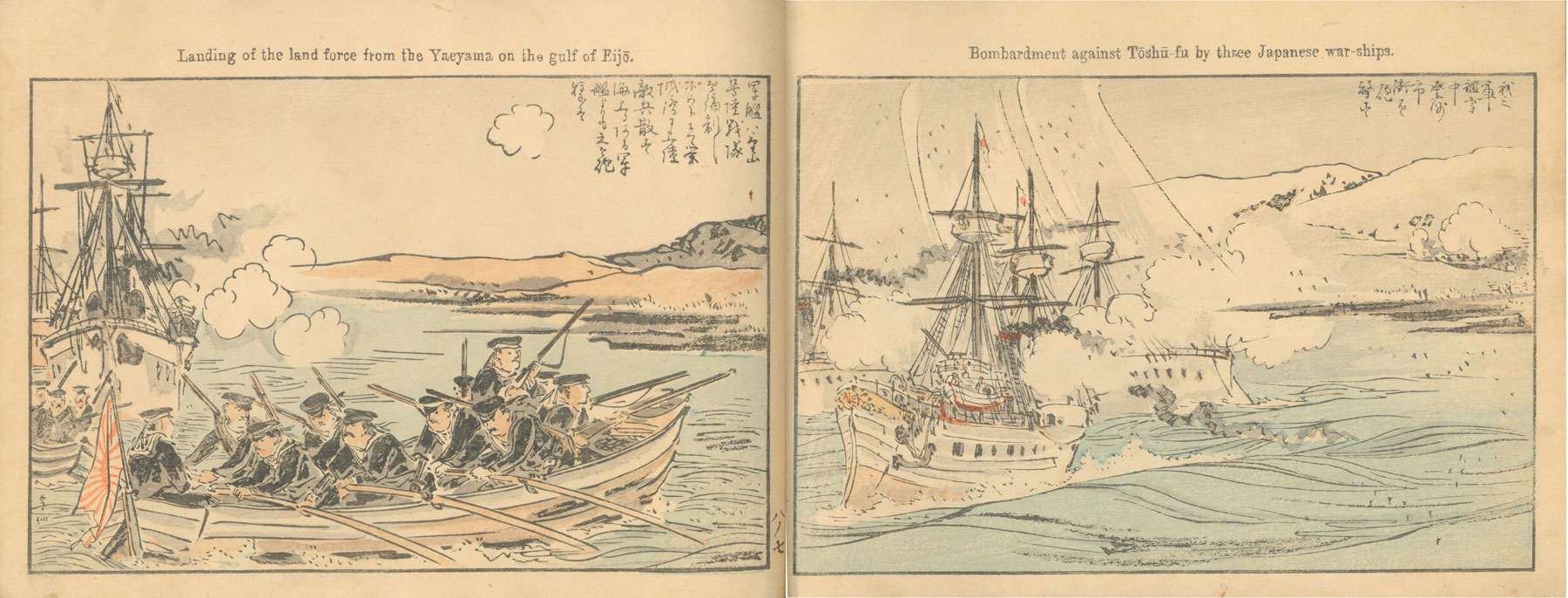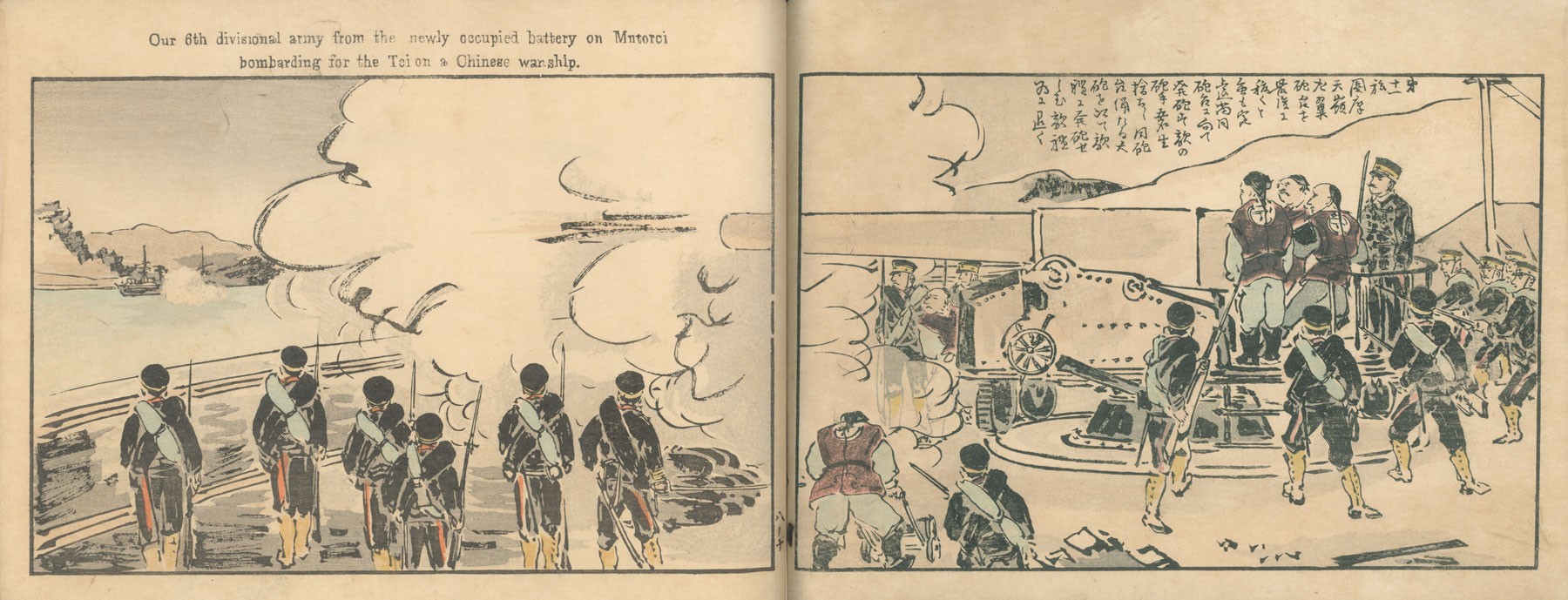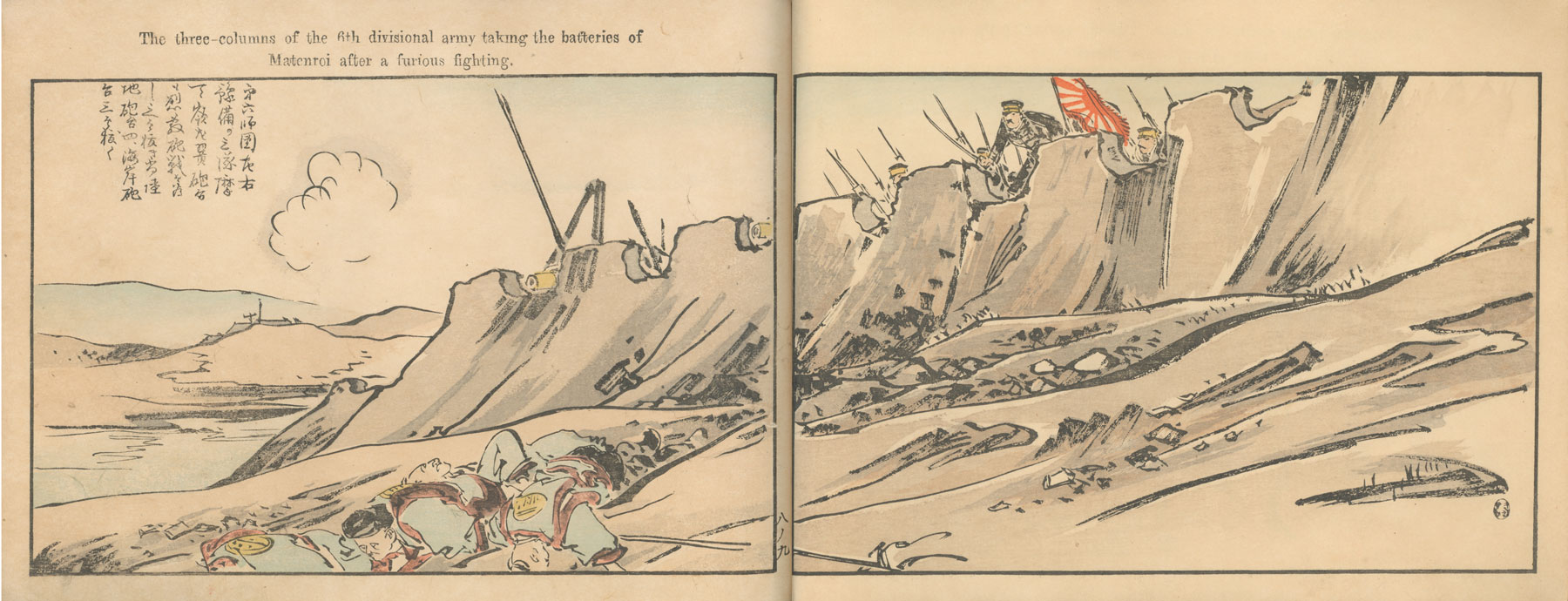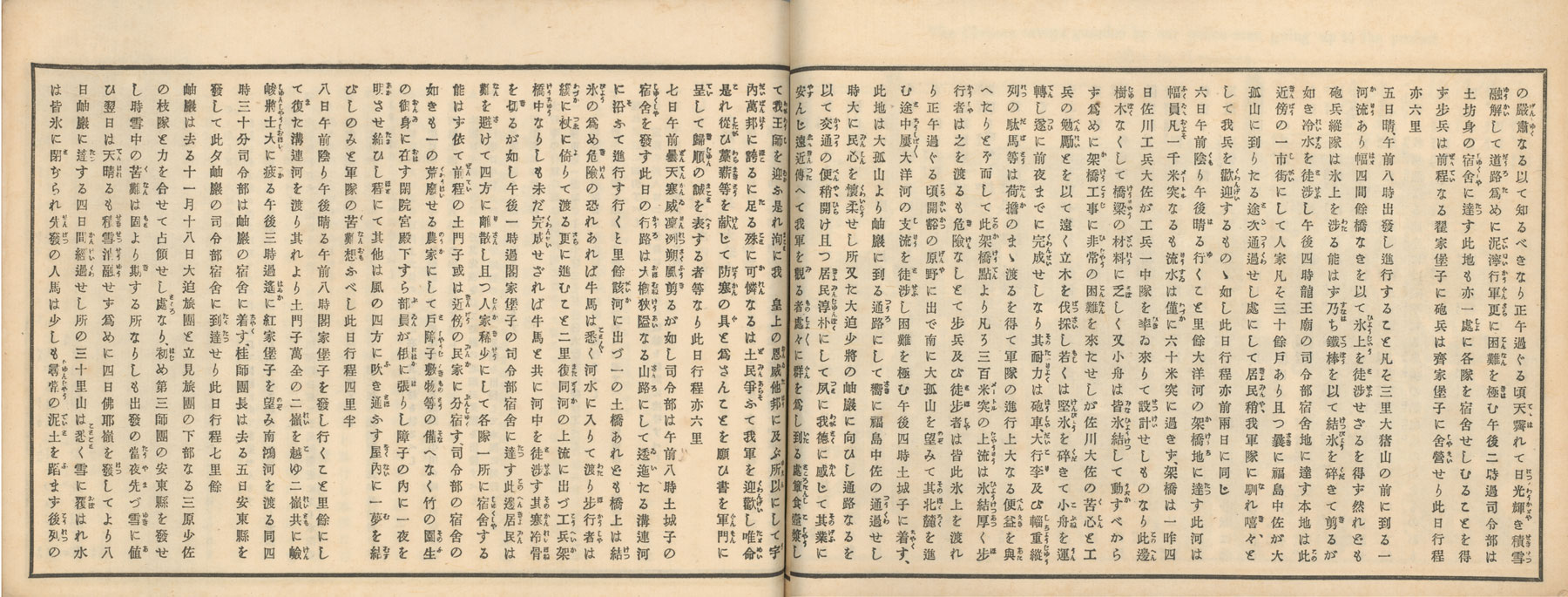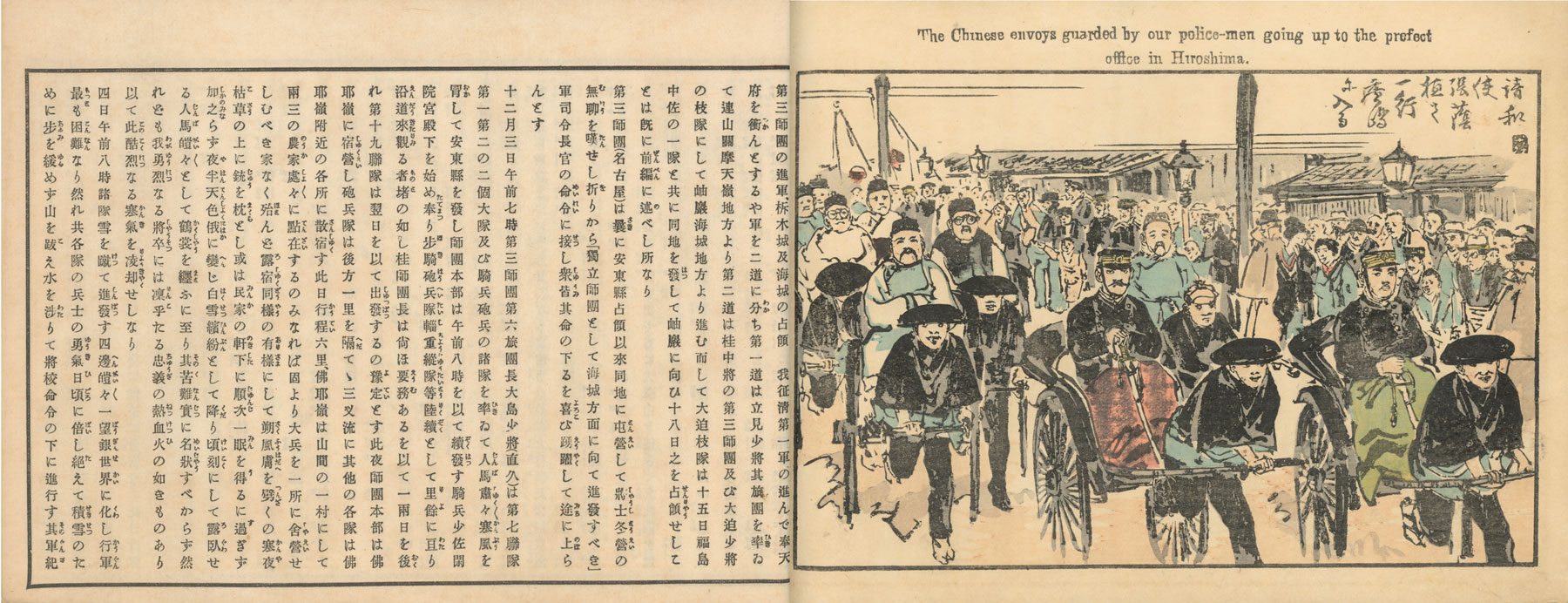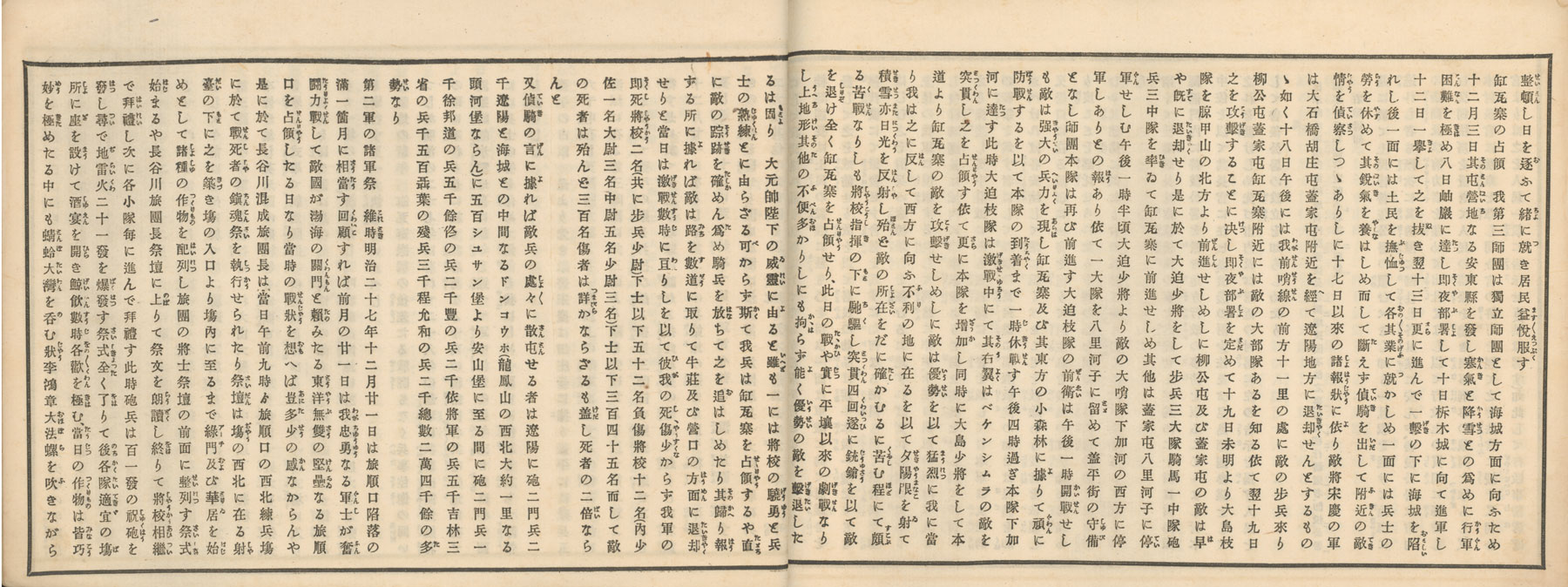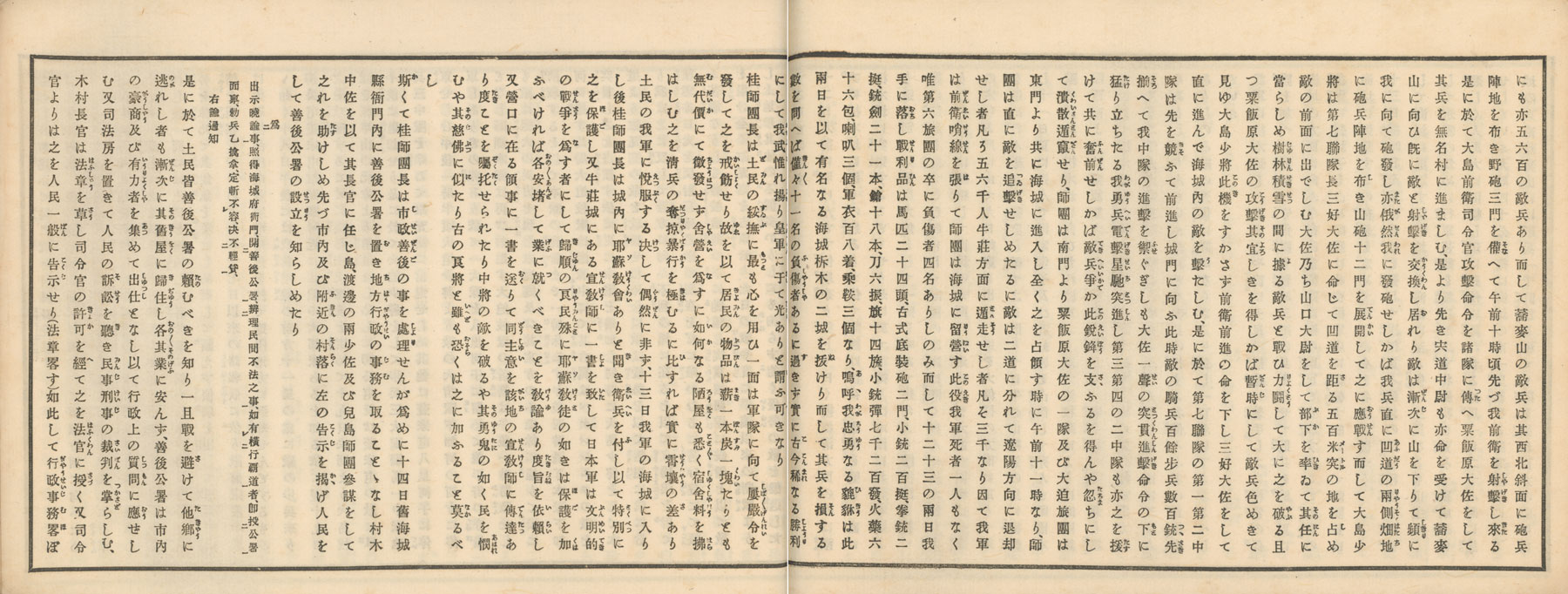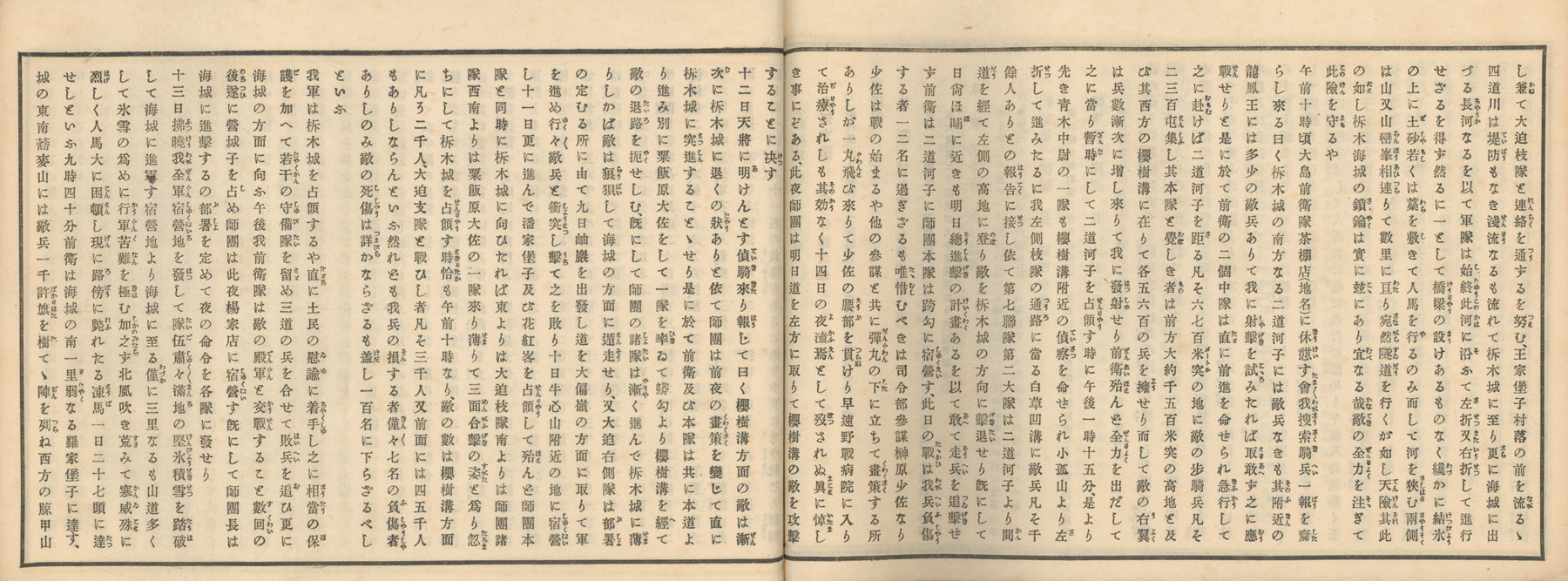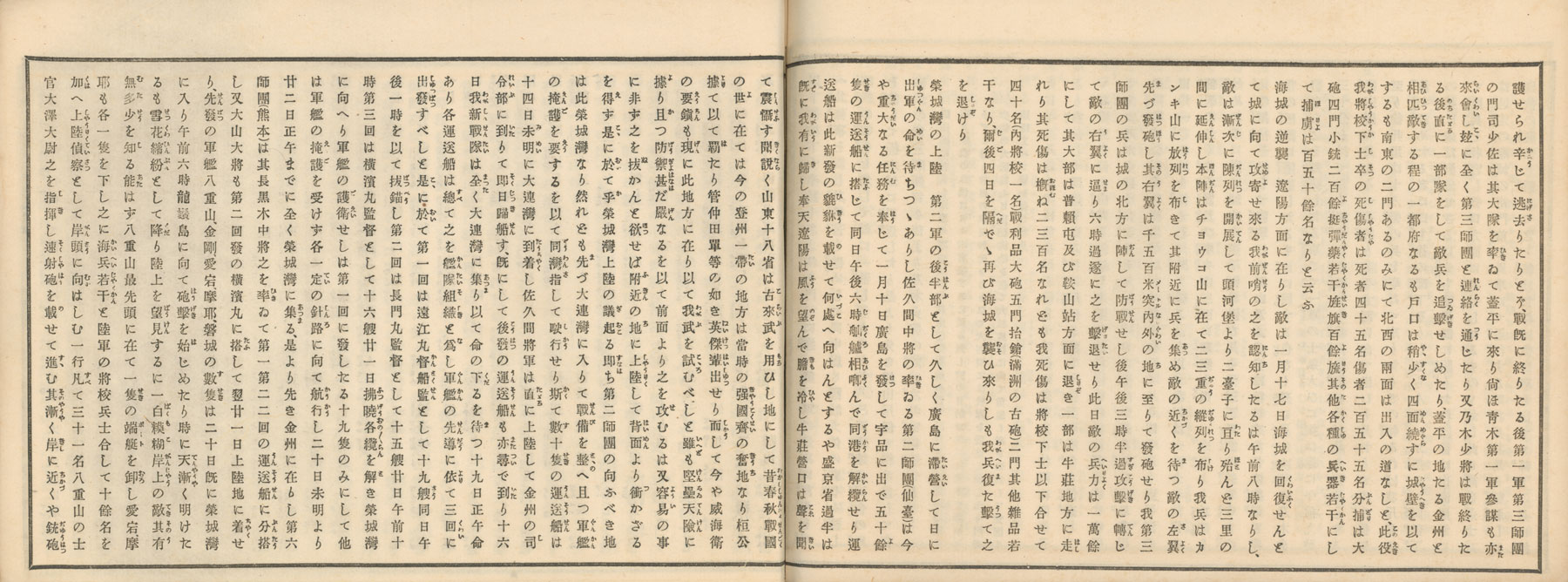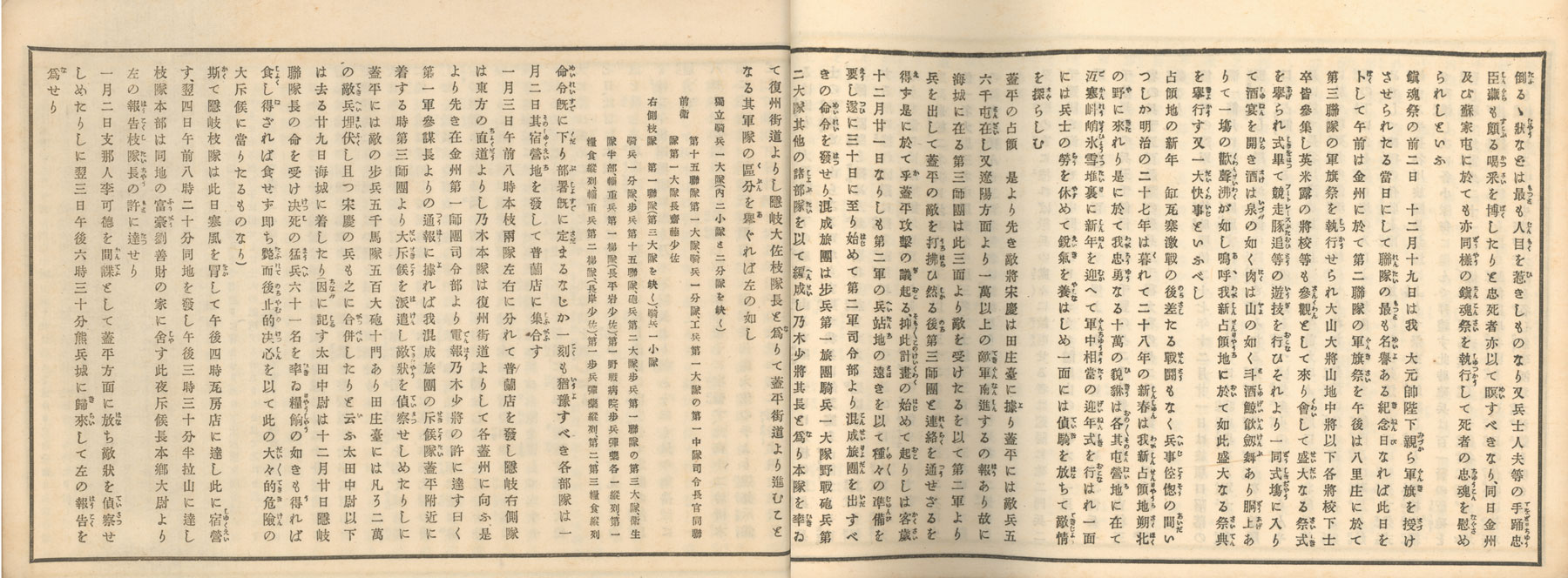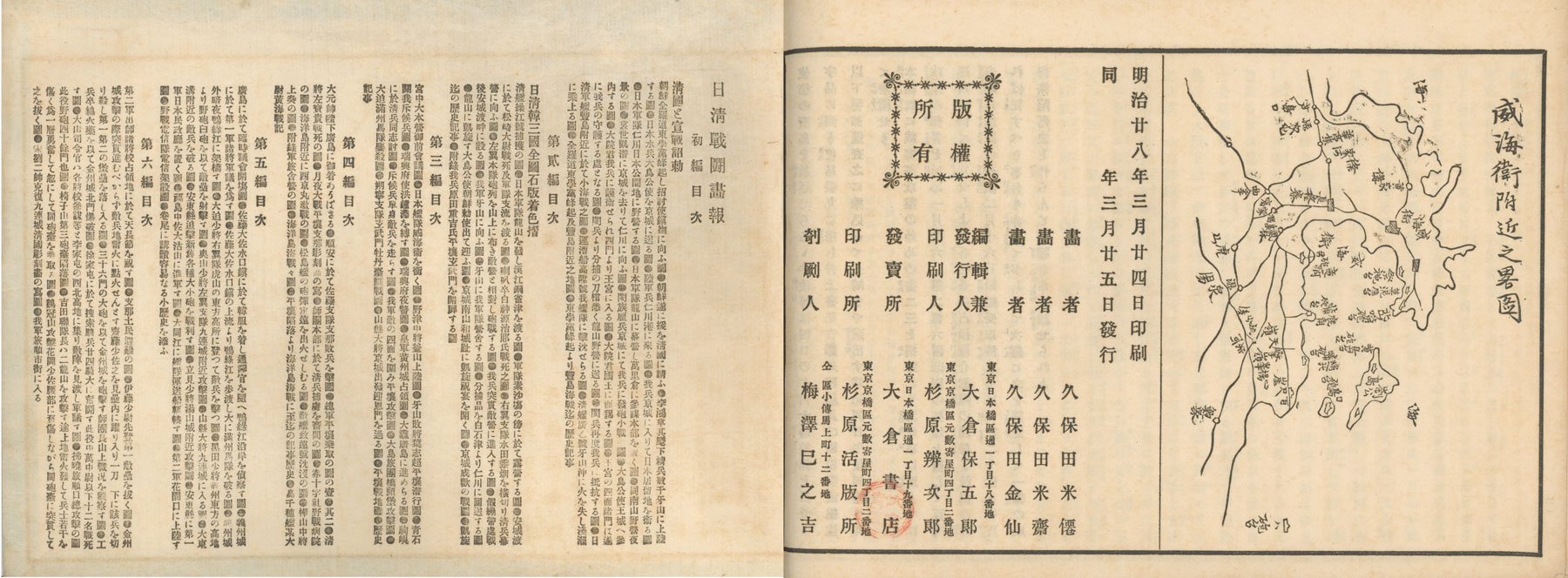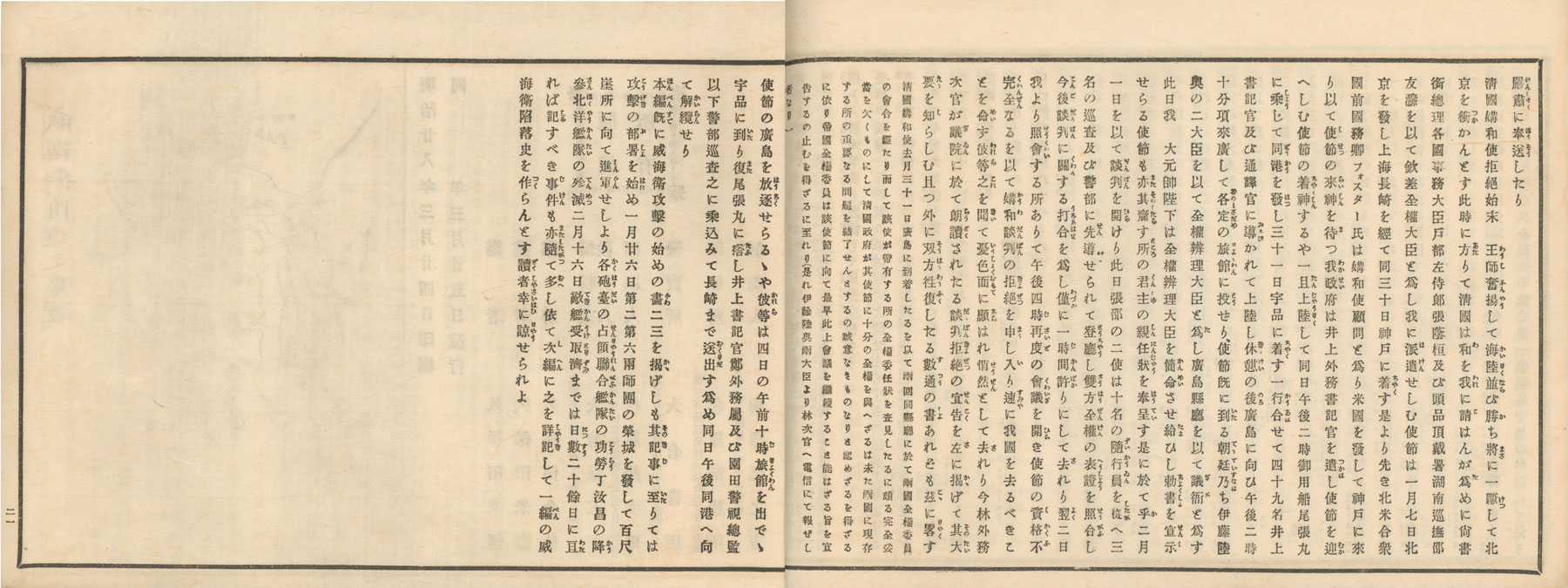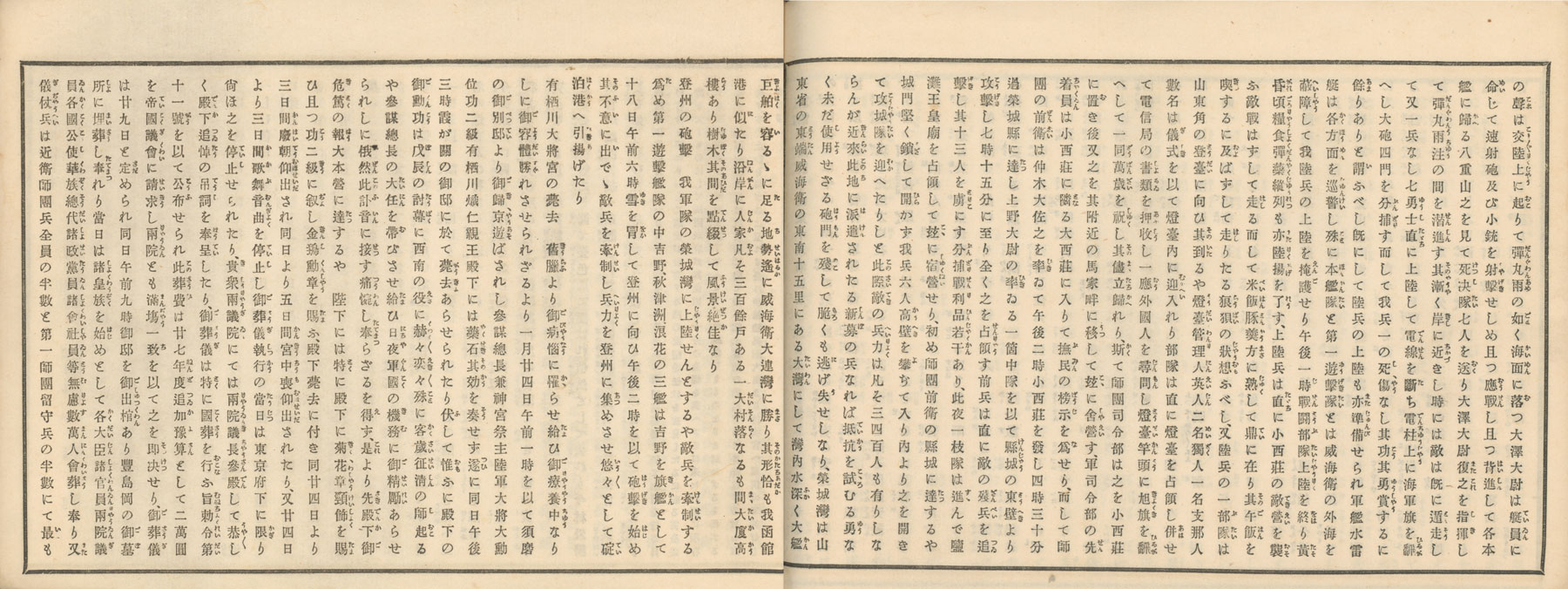About This Book
Volume 8 of a total of eleven bound volumes1 forming a pictorial account of the first Sino-Japanese War, from its outbreak in the summer of 1894 to Japan's sea-victories at Weihaiwei, Japan's advance into Manchuria and finally the peace treaty ending the war in April 1895. The eleven volumes were published at irregular intervals between October 21st 1894 and June 6th 1895. Each volume has an introduction written by a well-known figure of the time. The books were produced from carved woodblocks and are bound in the usual method of "bound-pocket books" (Fukuro toji 袋綴じ). Volumes 5 through 11 have English captions above the illustrations.The illustrations in these books were widely dispersed overseas to an audience closely following the war, as can be seen from the below illustrations from Volume 6 that appeared in the 1895 French publication Revue Encyclopédique: Recueil Documentaire Universel et Illustré, published by Georges Moreau in Paris.
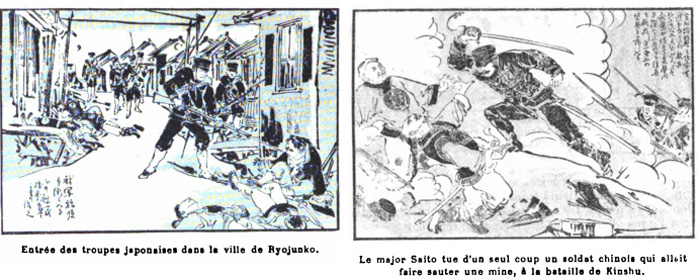
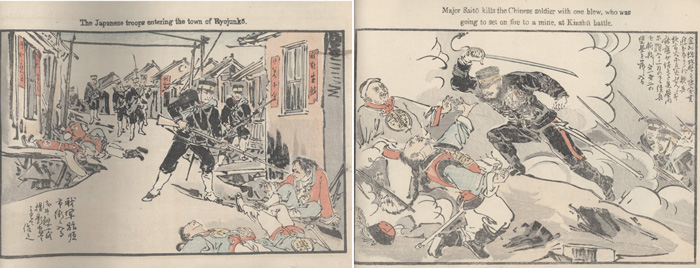
Images as they appear in Volume 6 of Illustrated Account of the Sino-Japanese War
Source: Japan at the Dawn of the Modern Age – Woodblock Prints from the Meiji Era, Louise E. Virgin, Donald Keene, et. al., MFA Publications, 2001, p. 68.
"A unique and important source of inspiration for the Sino-Japanese War print artists was the journalistic reports written and illustrated by the Kyoto painter Kubota Beisen (1852-1906). Accompanied by his two sons, Beisai and Kinsen, Beisen actually followed the troops [the First Army division] and recorded their battles in words and sketches. And Beisen himself was depicted almost as a war hero in a small number of triptych designs." (See the print Ban-Banzai for the Great Japanese Empire! Illustration of the Assault on Songhwan: A Great Victory for Our Troops.)
Source: A Much Recorded War: The Russo-Japanese War in History and Imagery, Fredrick A. Sharf, Anne Nishimura Morse, Sebastian Dobson, MFA Publications, 2005, p. 40-41.
"In their ten-volume2 Illustrated Record of the Battles of the Sino-Japanese War, from 1894-95, Beisen and his two sons describe the events of the war against a landscape this is beholden to East Asian literati painting and prints, with fibrous texture strokes used to define mountainsides and riverbanks and stippling to suggest the foliage on the trees. Yet the artists have consistently modeled the figures of the Japanese soldiers with light and darks to heighten the solidity of their forms. This modeling contrasts with the time-honored use of simple hooked outlines to define the figures of the Chinese combatants."
Source: A Much Recorded War: The Russo-Japanese War in History and Imagery, Fredrick A. Sharf, Anne Nishimura Morse, Sebastian Dobson, MFA Publications, 2005, p. 40-41.
"In their ten-volume2 Illustrated Record of the Battles of the Sino-Japanese War, from 1894-95, Beisen and his two sons describe the events of the war against a landscape this is beholden to East Asian literati painting and prints, with fibrous texture strokes used to define mountainsides and riverbanks and stippling to suggest the foliage on the trees. Yet the artists have consistently modeled the figures of the Japanese soldiers with light and darks to heighten the solidity of their forms. This modeling contrasts with the time-honored use of simple hooked outlines to define the figures of the Chinese combatants."
Advertisement
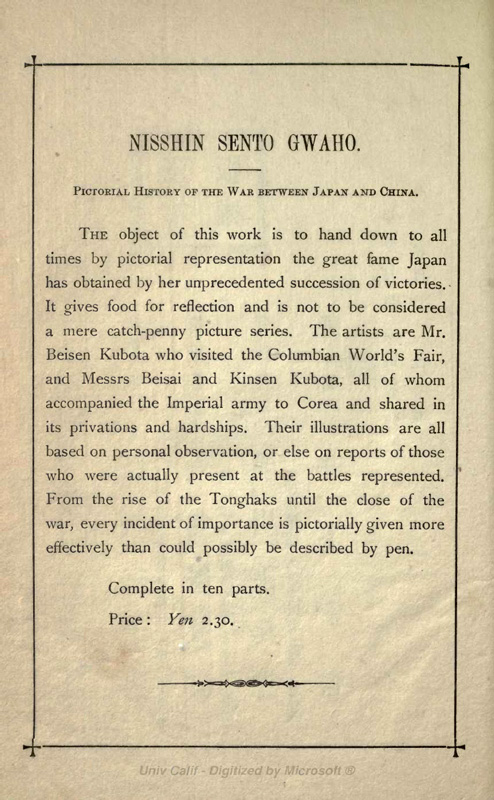
Advertisement appearing in A Concise History of the War Between Japan and China,
compiled by Jikichi Inouye, Osaka: Z. Mayekawa, Tokyo: Y. Okura, 1895.
compiled by Jikichi Inouye, Osaka: Z. Mayekawa, Tokyo: Y. Okura, 1895.
[note: while the ad states "Complete in ten parts." an eleventh volume was added at a later date.]
2015 Reprint of All Eleven Volumes
In 2015, the Osaka publisher Sōgensha 創元社 reprinted all eleven volumes in a single 470 page volume with additional commentary.
Egakareta Nisshin Sensō: Kubota Beisen "Nisshin sentō gahō": eiin, honkokuban, gasha Kubota Beisen, Kubota Beisai, Kubota Kinsen ; Ōtani Tadashi, Fukui Junko hen.
描かれた日清戦争 : 久保田米僊「日清戦闘画報」 : 影印・翻刻版
1 Ten volumes were originally planned, but an eleventh titled 凱旋編 (Triumphal Return) was added at a later date.
2 See note 1 above.
Volume 8, published on March 24, 1895, towards the end of the War, portrays war-related events in January 1895. It starts with New Year's celebrations in conquered Kinshu and ends with the January 31st arrival in Hiroshima of two Chinese plenipotentiaries, Chang In-hoon and Shao Yulien, to sue for peace (an effort that was refused by their Japanese counterparts.)1 It includes the siege of the critical coastal forts protecting Wei-Hai-Wei but not its final capture in mid-February. Illustrated is a mortally wounded Major General Ōdera "who was so severely wounded by a shell while in the Motienling fort that he died soon thereafter."2 A map of the area around Wei-Hai-Wei is provided at the back of the volume.
1 A Concise History of the War Between Japan and China, Jikichi Inouye, Osaka: Z. Mayekawa, Tokyo: Y. Okura, 1895, p. 83.
2 ibid., p. 76.
Notes:
1. All misspellings and grammatical errors in the captions have been carried forward. Where the names of Japanese military officers have been obviously translated into English incorrectly, I've corrected those names within brackets.
| page 2-3 序 Preface (cont.) Anniversary festival of the regimental flag celebrated at Kinshu. [signed Kinsen 金仙] | page 1 序 Preface |
| page 10-11 Chōshisei a Chinese general receiving a bullet in his loins escapes from the field in battle of Kōgasai." [Beisan seal] Two colonels Fujimoto & Satō defeating the Chinese in the second attack by them against Kaijō. | page 8-9 | page 6-7 Lieutenant Ōta & other 61 soldiers' adventure as the great spy-band making the junction of the 1st & 2nd corps d'armée. |
| page 16-17 The Japanese troops under the Prince Fushimi occupying the enemy's camp at Kozan near Ikaiei. | page 14-15 The 4th regiment under Maj. General Yamaguchi occupying Eijō-ken & setting the castle gate en fire. [unread signature] Assembling of war-ships & transports of the 2nd corps d'armée on the gulf of Eijō [unread signature] | page 12-13 Bombardment against Tōshū-fu by three Japanese war-ships. Landing of the land force from the Yaeyama on the gulf of Eijō |
page 20-21 Our 6th divisional army from the newly occupied battery on Mntorci bombarding for the Tei on a Chinese warship. | page 18-19 The three-columns of the 6th divisional army taking the batteries of Matenroi after a furious fighting. [Beisen seal] |
| page 28-29 | page 26-27 | page 24-25 The Chinese envoys guarded by our police-men going up to the prefect office in Hiroshima. [Beisen seal] |
page 46-47 威海衛所近之畧图 rough battle map of Weihaiwei colophon 明治廿八年三月廿四日印刷 明治廿八年三月廿五日發行 畵者 久保田米僊 畵者 久保田米齊 畵者 久保田金仙 編輯兼 発行人 大倉保五郎 印刷人 杉原辨次郎 発賣所 大倉書店 印刷所 杉原活版所 剞劂人 梅澤巳之吉 published on March 25, 1895 painter Kubota Beisen painter Kubota Beisai painter Kubota Kinsen editor and publisher Ōkura Yasugorō printer Sugihara Benjirō publishing house Ōkura shoten printing office Sugihara kappanjo carver Umezawa Minokichi 初編目次 第貮編目次 第三編目次 第四編目次 第五編目次 第六編目次 Illustrated Account of the Sino-Japanese War Table of contents for the first six chapters | page 44-45 | page 42-43 |
Book Details
| IHL Catalog | #549 |
| Title/Description | Illustrated Account of the Sino-Japanese War, Volume 8 日清戦闘畫報* 第八編 (Nisshin Sentō Gahō, daihachi hen) *typically seen written as 日清戦闘画報 [also written as 日清戰鬪畫報 and 日清戰鬥畫報] |
| Artist |  left: detail from colophon 畫者 [illustrators]: 久保田 米 僊 久保田 米 齊 久保田 金 仙 |
| Signature | illustrations not signed unless noted on above thumbnails |
| Seal | illustrations not sealed unless noted on above thumbnails |
| Publication Date | March 25, 1895 明治廿八年三月二五日發行 |
| Edition | |
| Publisher | Ōkura Yasugorō 大倉保五郎 (Ōkura shoten)- Tokyo |
| Carver | Umezawa Minokichi 梅澤巳之吉 |
| Printer | Sugihara Benjirō 杉原辨次郎 |
| Impression | excellent |
| Colors | excellent |
| Condition | good - minor toning and staining throughout; binding and all pages in tact with little edge or paper wear |
| Miscellaneous | |
| Genre | ehon 絵本; senso-e |
| Format | fukurotoji |
| H x W Paper | 6 3/4 x 9 1/4 in. (17.1 x 23.5 cm) |
| Collections This Book | Museum of Fine Arts, Boston 2000.338 (Volume 3); Victoria & Albert Museum E.2531-1925 (volumes 1-5 and 8); Rijksmuseum Netherlands RP-P-2005-594; Japanese Special Collection in Sterling Memorial Library at Yale University, ID #1121 (Volume 3); UCLA Libraries and Collections Record ID 2035932 (Volumes 1-3); University of Chicago Library Call No.: J6289.2 2269 (Volumes 1-3); Cornell University Library call number Asai Rare DS765.K95 (Volumes 1-11); Williamsburg Research Libraries Partnership Swem Library DS765 .K82 v.1 (Volumes 1-11); Columbia University Libraries East Asian SPECIAL COLL. DS765.K82 1894 (Volumes 1-11); Brown University Library Hay Military DS765.K83x 1894 (Volumes 1-8); Harvard University HOLLIS: 007566215 (Volumes 1-11); National Diet Library (Volumes 1, 2, 3, 6, 8); St. Louis Museum of Art 854.2010, 855.2010, 848.2010 (Volumes 4, 5, 8) |
| Reference Literature | Japan at the Dawn of the Modern Age – Woodblock Prints from the Meiji Era, Louise E. Virgin, Donald Keene, et. al., MFA Publications, 2001, ill. 23, p. 63; In Battle's Light: Woodblock Prints of Japan's Early Modern Wars, Elizabeth de Sabato Swinton, Worcester Art Museum, 1991, p. 14; The World of the Meiji Print: Impressions of a New Civilization, Julia Meech-Pekarik, Weatherhill, 1986 p. 206; Conflicts of Interest: Art and War in Modern Japan, Philip K. Hu, et. al., Saint Louis Museum of Art, 2016, p. 158-160. |
5/16/2020
12/8/2018



